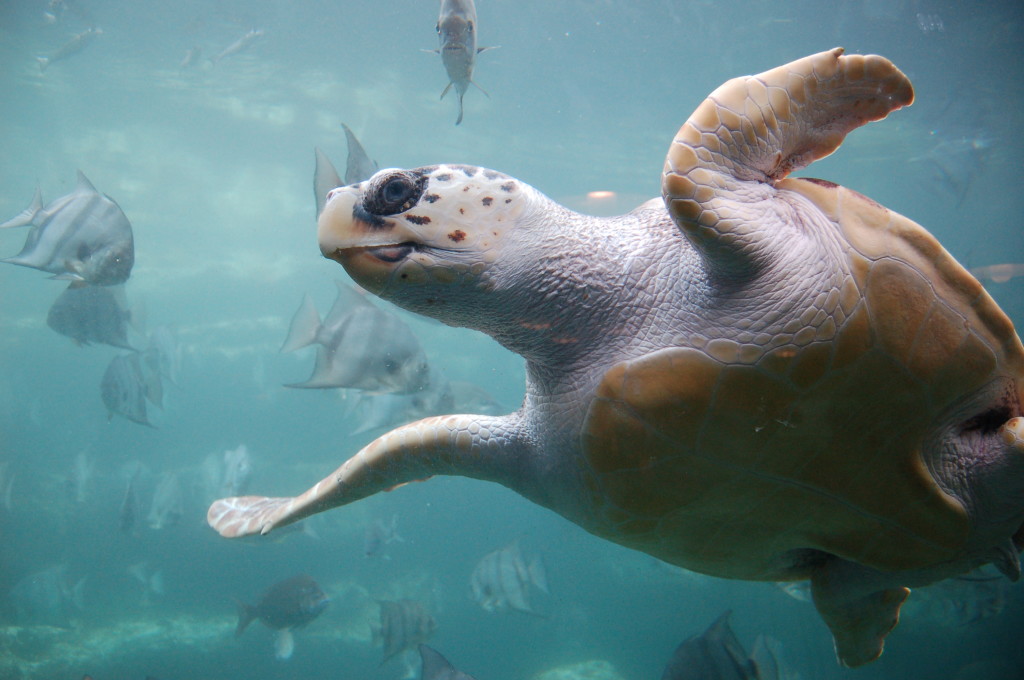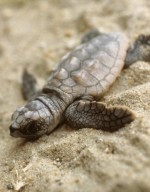
In a time of increasing disregard for the environment within Turkey, the conservation work being undertaken to protect endangered marine turtles on the southwest coast of Turkey comes as a breath of fresh air. Located close to the bustling tourist town of Dalyan, Turkey’s only turtle rescue center, the Sea Turtle Research Rescue and Rehabilitation Centre (Deniz Kaplumbağaları Araştırma Kurtarma ve Rehabilitasyon Merkezi, or Dekamer) can be found in an oasis of natural beauty.
With 360 degree views of the Mediterranean Sea, mountains, lakes, lagoons, rivers and a river delta, not to mention stunningly soft white sand, the 4.5-km-long Iztuzu Beach is a wonder to behold. Aside from its obvious beauty, it is the natural importance of Iztuzu that makes it such an important location for biologists and conservationists alike: for millions of years, Caretta caretta – otherwise known as Loggerhead Turtles – have taken advantage of the shallow depth and fine sand, using it as a location for nesting during the summer breeding season.
The center was set up in 2009 by Professor Yakup Kaska, a biology researcher and lecturer from Pamukkale University and a man who has been involved in the research and conservation of sea turtles on Iztuzu for 25 years. Dekamer, combines valuable research projects with the day-to-day duties of the turtle hospital, caring for sick and injured turtles brought in from all around the Mediterranean coast of Turkey, with the ultimate goal of releasing them back into the wild once rehabilitated.
The story of conservation at Iztuzu stretches back over two-and-a-half decades. In 1987, rumors about plans to build an 1,800-bed hotel on the beach began to circulate, and in some places foundations were even laid. Without the work of an international conservation campaign supported by International Union for Conservation of Nature (IUCN), Greenpeace and the World Wildlife Fund, led by British conservationists June Haimoff and David Bellamy, Iztuzu would have been just another resort hotel, like the multitude located along the Mediterranean coast. Thanks to the tireless campaigning of local and international conservationists, the beach was saved and became the first specially protected area in Turkey.
Sadly, nearby Sarigerme Beach (once a similarly important nesting area for Loggerheads), and the beaches of Belek, located just outside of Antalya, haven’t been as lucky, with nesting numbers steadily dropping over the past decade as a result of building projects. Iztuzu is one of only three turtle-nesting beaches that is protected in Turkey, the others being Patara Beach near Antalya and Akyatan Beach close to Adana, and even these beaches face an uphill struggle to remain undisturbed.
The designation of protected status prevents building developments on Iztuzu Beach. The turtle rescue center Dekamer is made up of numerous containers, tents and caravans. The only other signs of human development are two small cafes, sunbeds, toilets and changing facilities located on each end of the beach. As well as restrictions on buildings, there are strict rules prohibiting visitors from visiting the beach between 20:00 and 8:00, as well as bans on vehicles, dogs and the use of boats within a one-mile radius. For years, this system has worked, with the biologists and volunteers at Dekamer and the belediye staff employed by the cafes working in unison to ensure the conservation and protection of the beach. However, last month saw the staging of protests in Dalyan and at Iztuzu in response to the belediye’s decision to sell the two cafes, causing widespread concerns for the welfare of the beach, with many fearing the privatization of the recreational areas on the beach will lead to building developments.
With this level of uncertainty and concern surrounding the long-term future of the beach, and as a result, one of the most important nesting locations for Loggerheads in the Mediterranean, conservation and support for the area is more important than ever. Both Caretta caretta and Chelonia mydas (green turtle) – the two native nesting species of marine turtle in the Mediterranean – are highly endangered species, and the destruction of the second-most important nesting beach for Loggerheads in the Mediterranean would be sure to have catastrophic consequences.
The threats to marine turtles include pollution (with plastic bags a particular threat to the carnivorous Loggerheads, who mistake them for jellyfish), small-scale and large-scale fishing (primarily fishing hook ingestion and fishing line entanglement), feeding by humans (leading to poor nutrition and atypical behavior), propellers and, most distressingly, fisherman intentionally trying to kill turtles (one can only assume that they see them as a threat to fishing stocks).
Recent projects have been undertaken in the area such as regular cleaning of coastal areas, as well as initiatives to encourage the use of protective guards around the propellers/props on boats. The latter is where visitors can get involved by checking to make sure that any mechanized boat they go on has one of these protective guards.
Another issue is that numerous tour boats and restaurants treat the turtles as a tourist attraction, regularly feeding them to draw crowds. While the practice of feeding the animals chicken, bread and other unnatural foods has decreased, many still feed the turtles blue crab and other seafood, claiming it has no harm or effect on the turtles as a result of being part of their natural diets. This practice is very much discouraged as any feeding of wild animals is highly unnatural, putting turtles at risk of being hit by propellers, causing aggressive behavior, as well as affecting their natural feeding habits.
The most important and easiest way for people to get involved is simply through raising awareness of the dangers faced by marine turtles both locally in the Mediterranean, and globally as a whole. These magnificent and enchanting prehistoric species have found their numbers steadily decreasing in conjunction with the increasing levels of industrial development.
A more worrying recent phenomenon is the effects rising temperatures are having on sea turtles. During the gestation period of the eggs, sex ratio is dependent on temperature, with lower temperatures leading to more males and higher temperatures more females. As global temperatures rise, the sand – which acts as an incubator for turtle eggs – will rise in temperature too, and could eventually lead to a population of turtles comprised entirely of females, preventing reproduction and ultimately leading to extinction. As such, the conservation of marine turtles is more important than ever, and the work being undertaken by sea turtle rescue and research centers like Dekamer is invaluable. Dekamer and other similar institutions rely primarily on donations, so any support, large or small, is greatly appreciated.

Another way you can get involved in the protection and conservation of sea turtles is through volunteering. In the words of Professor Kaska and the biologists from Pamukkale University, the volunteers are the heart and soul of Dekamer. The summer period from May until September is extremely busy at Iztuzu, being both tourist and nesting/hatching season, and the center relies on the support of a dedicated team of volunteers from countries as far afield as Hong Kong, Estonia and Australia. For more information about the volunteering you can visit the volunteering section on Dekamer’s website. Alternatively, you can read my next article, which is a first-hand account of my recent volunteering experience at Dekamer.
Timur Jack-Kadıoğlu is a contributor for Yabangee.










[…] at a conservation or community […]
[…] my previous article, I discussed the on-going conservation work taking place at Iztuzu Beach, a place of magnificent […]